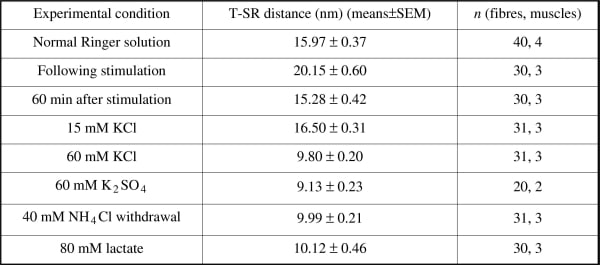We thank the MRC, Wellcome Trust and Astra Zeneca.
University of Heidelberg (2006) Proc Physiol Soc 4, PC7
Poster Communications: Juliet A. Usher-Smith1, Christopher L. Huang1, James A. Fraser1, Jeremy N. Skepper2
1. Department of Physiology, Development and Neuroscience, University of Cambridge, Cambridge, United Kingdom. 2. Multi-Imaging Centre, University of Cambridge, Cambridge, United Kingdom.
Excitation-contraction coupling in skeletal muscle probably involves specific allosteric interactions between transverse (T)-tubular dihydropyridine receptors and sarcoplasmic reticular (SR) ryanodine receptors (Franzini-Armstrong & Protasi, 1997). This coupling is therefore potentially vulnerable to anatomical disruption of T-SR membrane spacing. This study on Rana temporaria sartorius muscles examined the effect of fatiguing electrical stimulation on this T-SR distance and compares this with exposing resting fibres to a range of extracellular conditions that each replicate one of the major changes associated with muscular activity: membrane depolarisation, volume increase, acidification and intracellular lactate accumulation. Following each treatment, muscles were immersed in isotonic fixative solution and processed for electron-microscopy. Mean distances between junctional SR and the T-system were estimated using the orthogonal intercept method to provide unbiased stereological estimators of diffusion distances between T and SR membranes (Jenson et al. 1979). Measurements from muscles fatigued by low frequency intermittent stimulation (80 sets of a 2s stimulus at intervals of 8s with impulses 20ms long at 20V and 25Hz) showed significant (p << 0.05) reversible increases in T-SR distance (Table 1). Exposure to isosmotic 15mM extracellular [K+] to produce membrane depolarisation and cell swelling comparable to that following stimulation did not significantly affect T-SR distance although increasing extracellular [K+] to 60mM reduced it. This latter finding persisted with Cl- deprivation which prevents the volume changes normally accompanying increased [K+] (Usher-Smith et al. 2006b), thereby excluding additional effects of isosmotic cell swelling. Acidification alone produced by NH4Cl addition and withdrawal also decreased T-SR distance and a similar reduction occurred following exposure to extracellular Na-lactate where such acidification was accompanied by elevations of intracellular lactate (Usher-Smith et al. 2006a). Thus, under these conditions, lactate has no additional effect on T-SR distance. Overall, this study demonstrates significant increases in T-SR distances following stimulation, whilst showing that membrane depolarisation and acidification decrease T-SR distance and isosmotic volume changes and lactate appear to have no additional effect.
View other abstracts by:
Table 1
Where applicable, experiments conform with Society ethical requirements.

